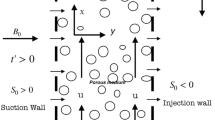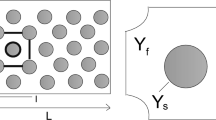Abstract
The results of direct numerical simulation of turbulent flows of non-Newtonian pseudoplastic fluids in a straight pipe are presented. The data on the distributions of the turbulent stress tensor components and the shear stress and turbulent kinetic energy balances are obtained for steady turbulent flows at the Reynolds numbers of 104 and 2×104. As distinct from Newtonian fluid flows, the viscous shear stresses turn out to be significant even far from the wall. In power-law fluid flows the mechanism of the energy transport from axial to transverse component fluctuations is suppressed. It is shown that with decrease in the fluid index the turbulent transfer of the momentum and the velocity fluctuations between the wall layer and the flow core reduces, while the turbulent energy flux toward the wall increases. The earlier-proposed models for the average viscosity and the non-Newtonian one-point correlations are in good agreement with the data of direct numerical simulation.
Similar content being viewed by others
References
M. R. Malin, “Turbulent Pipe Flow of Power-Law Fluids,” Int. Comm. Heat Mass Transfer 24, 977 (1997).
F. T. Pinho, “A GNF Framework for Turbulent Flow Models of Drag Reducing Fluids and Proposal for a k–e Type Closure,” J. Non-Newtonian Fluid Mech. 114, 149 (2003).
D. O. A. Cruz and F. T. Pinho, “Turbulent Pipe Flow Predictions with a Low Reynolds Number k–e Model,” J. Non-Newtonian Fluid Mech. 114, 109 (2003).
D. O. A. Cruz, F. T. Pinho, and P. R. Resende, “Modelling the New Stress for Improved Drag Reduction Predictions of Viscoelastic Pipe Flow,” J. Non-Newtonian Fluid Mech. 121, 127 (2004).
A. A. Gavrilov and V. Ya. Rudyak, “Reynolds-Averaged Modeling of Turbulent Flows of Power-Law Fluids,” J. Non-Newtonian Fluid Mech. 227, 45 (2016).
M. Rudman, H. M. Blackburn, L. J. W. Graham, and L. Pullum, “Turbulent Pipe Flow of Shear-Thinning Fluids,” J. Non-Newtonian Fluid Mech. 118, 33 (2004).
M. Rudman and H. M. Blackburn, “Direct Numerical Simulation of Turbulent Non-Newtonian Flow Using a Spectral Element Method,” Appl. Math. Model. 30, 1229 (2006).
H. R. Anbarlooei, D. O. A. Cruz, and A. P. Silva Freire, “The Logarithmic Solution of Purely ViscousNon-Newtonian Fluids,” in: Proc. 10th Intern. ERCOFTAC Symp. Engineering Turbulence Modelling and Measurements (ETMM10). 17–19 September 2014, Spain, Maribella, 2014 (2014).
P. S. Gnambode, P. Orlandi, M. Ould-Rouiss, and X. Nicolas, “Large Eddy Simulation of Turbulent Pipe Flow of Power-Law Fluids,” Int. J. Heat Fluid Flow 54, 196 (2015).
T. Ohta and M. Miyashita, “DNS and LES with an Extended Smagorinsky Model for Wall Turbulence in Non-Newtonian Viscous Fluids,” J. Non-Newtonian Fluid Mech. 206, 29 (2014).
A. A. Gavrilov and V. Ya. Rudyak, “Turbulent Energy Balance for Turbulent Pipe Flow of a Pseudoplastic Fluid,” in: Reports of the 5th All-Russian Conf. ‘Fundamentals of MEMS and Nanotechnologies’. 2015. Vol. 1. Issue 4 [in Russian], Novosibirsk (2015), p. 121.
A. A. Gavrilov, “Direct Numerical Simulation of Turbulent Pipe Flow of a Pseudoplastic Fluid,” in: Reports of the 11th All-Russian Congress on the Fundamental Problems of Theoretical and Applied Mechanics. Kazan, 2015 [in Russian], Kazan (2015), p. 838.
A. A. Gavrilov and V. Ya. Rudyak, “Direct Numerical Simulation of Turbulent Flows of Power-Law Fluids in Round Pipes,” Teplofiz. Aeromekh. 23, 489 (2016).
A. A. Gavrilov, A. V. Minakov, A. A. Dekterev, and V. Ya. Rudyak, “Numerical Algorithm for Modeling Laminar Flows in an Annular Channel with Eccentricity,” Sib. Zh. Industr. Mat. 13(4), 3 (2010).
A. A. Gavrilov, A. V. Minakov, A. A. Dekterev, and V. Ya. Rudyak, “Numerical Algorithm for Modeling Steady Laminar Flows of Non-Newtonian Fluids in an Annular Gap with Eccentricity,” Vychisl. Tekhnol. 17 (1), 44 (2012).
F. Gori and A. Boghi, “A Three-Dimensional Exact Equation for the Turbulent Dissipation Rate of Generalized Newtonian Fluids,” Int. Commun. Heat Mass Transfer 39, 477 (2012).
N. V. Nikitin, “Direct Numerical Modeling of Three-Dimensional Turbulent Flows in Pipes of Circular Cross Section,” Fluid Dynamics 29 (6), 749 (1994).
N. V. Nikitin, “Statistical Characteristics of Wall Turbulence,” Fluid Dynamics 31 (3), 361 (1996).
K. Fukagata and N. Kasagi, “Highly Energy-ConservativeFinite Difference Method for the CylindricalCoordinate System,” J. Comput. Phys. 181, 478 (2002).
X. Wu and P. Moin, “A Direct Numerical Simulation Study on the Mean Velocity Characteristics in Turbulent Pipe Flow,” J. Fluid Mech. 608, 81 (2008).
D. W. Dodge and A. B. Metzner, “Turbulent Flow of Non-Newtonian System,” AICHE J. 199, 189 (1959).
J. B. R. Loureiro and A. P. Silva Freire, “Asymptotic Analysis of Turbulent Boundary-Layer Flow of Purely Viscous Non-Newtonian Fluids,” J. Non-Newtonian Fluid Mech. 199, 20 (2013).
A. A. Gavrilov and V. Ya. Rudyak, “Modeling the Molecular Viscosity Coefficient of Viscoplastic Fluids in the Turbulent Regime,” Dokl. Akad Nauk Vyssh. Shkol. RF No. 2, 55 (2013).
A. A. Gavrilov and V. Ya. Rudyak, “A Model of Averaged Molecular Viscosity for Turbulent Flows of Non-Newtonian Fluids,” J. Siberian Federal Univ. Math. Phys. 7 (1), 46 (2014).
Author information
Authors and Affiliations
Corresponding author
Additional information
Original Russian Text © A.A. Gavrilov, V.Ya. Rudyak, 2017, published in Izvestiya Rossiiskoi Akademii Nauk, Mekhanika Zhidkosti i Gaza, 2017, No. 3, pp. 31–43.
Rights and permissions
About this article
Cite this article
Gavrilov, A.A., Rudyak, V.Y. Direct numerical simulation of the turbulent energy balance and the shear stresses in power-law fluid flows in pipes. Fluid Dyn 52, 363–374 (2017). https://doi.org/10.1134/S0015462817030048
Received:
Published:
Issue Date:
DOI: https://doi.org/10.1134/S0015462817030048




